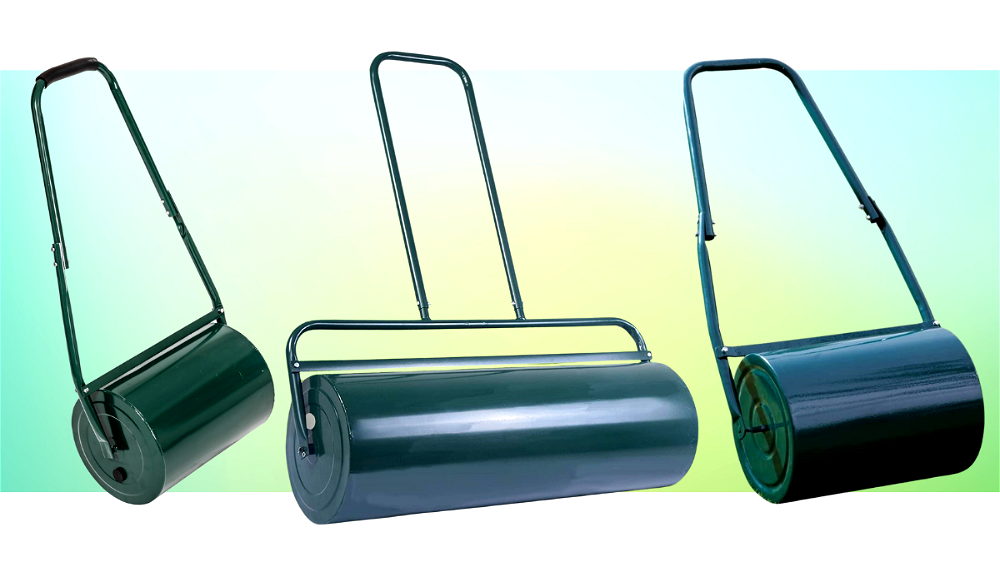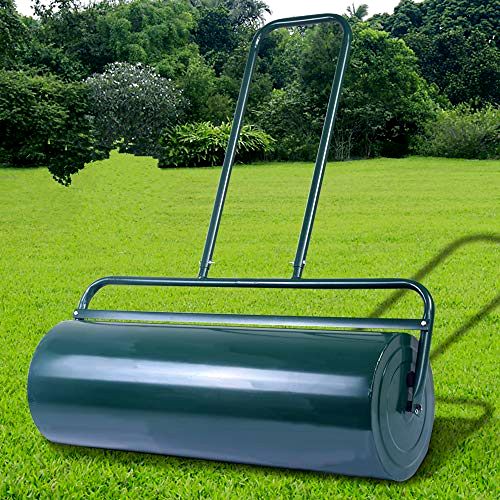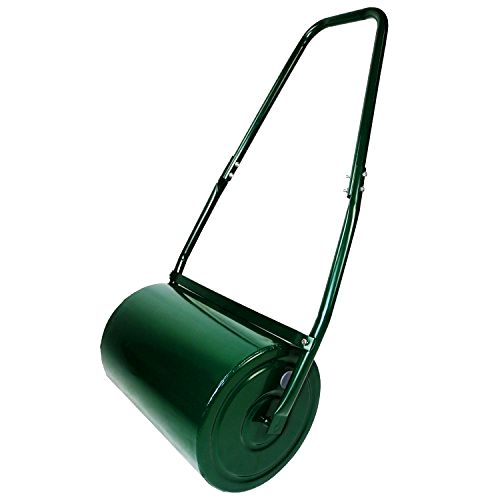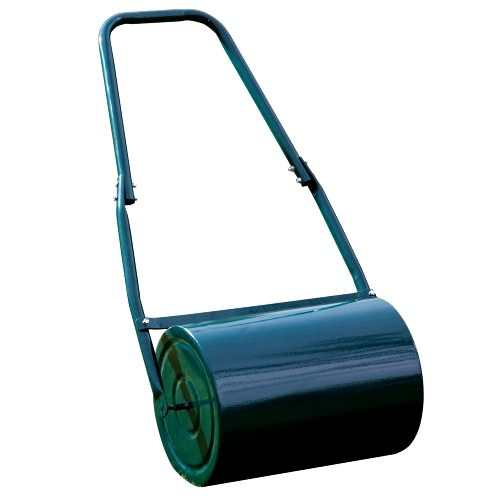Read Reviews
The Best Lawn Rollers

-
Best heavy duty lawn roller - Costway Heavy Duty 63 Litre Lawn Roller
-
Best value for money - Oypla Galvanised Steel Lawn Roller
-
Best for small/medium lawns - Garden Gear Heavy Duty Manual Push Lawn Roller
Lawn Roller Reviews
1. Costway Heavy Duty 63 Litre Lawn Roller
Best heavy duty lawn roller
- The handle folds down for easy storage in tight spaces
- When not filled, this roller is sufficiently lightweight and easy enough to move into storage
- A great option for medium to large size lawns thanks to its 90 cm width
- Easy to both fill and drain
- Weighs 110 kg when filled with sand which is heavy enough for stubborn bumps
- The width makes it a little tricky to manoeuvre around tight spaces
- Although easy to use, there is no padding on the handle which makes it less comfortable than others on the market
- When filled to capacity, this roller may damage softer areas of lawn due to its heavy weight
- The 90 cm width means weight is distributed rather than concentrated in a smaller space
- Drum Capacity
- 63 L
- Weight
- 13 kg
- Width of Drum
- 90cm
- Ease of Filling
- 4.5
- Ease of Use
- 4.5
- Value for Money
- 4.4
For domestic gardens it doesn’t get much more substantial than this 90 cm-wide Costway Heavy Duty 63 Litre Lawn Roller. This heavy duty option is the biggest featured here and it’s definitely the best lawn roller for large spaces.
The 63 L drum weighs around 110 kg when filled with sand, and 75 kg when filled with water. Of course, buying 65 L of sand is no joke, so it’s cheaper and easier to fill up with water, but helpful to have the option of a heavier weight if necessary.
If you’ve had a bit of a mole takeover in the garden, and are keen to flatten out their hills, or have soil that you want to pack down, this steel roller is a good tool to have around. It can also be used to prepare areas for seeding, or create stripes on the lawn.
Like most steel rollers, it requires some assembly on arrival. Fortunately, all of the holes are pre-drilled so it’s simply a case of screwing the parts together which doesn’t take long.
The galvanised-steel construction is pretty hardy and doesn’t rust quickly, but even so this lawn roller should be stored under cover when not in use because it’s not completely rust-resistant. There is a low scraper bar across the top, to stop debris from getting stuck to the drum, and a removable drain plug.
Speaking of storage, finding a place for this roller may prove a little tricky, simply because it’s such a wide object. Although, having said this, it can actually be stood upright for storage, which dramatically reduces its footprint.
Something else to bear in mind is that this lawn roller struggles to flatten more prominent, uneven patches of lawn – it’s best suited to rolling out divots, mole hills and soil. This may be because, due to its large width, the weight isn’t highly concentrated in just one area.
Overall, this is one of the best lawn rollers for large lawns. It’s a sturdy steel lawn roller that can cover larger areas in less passes. It’s also easy to fill and drain.
Did you find this review helpful?
2. Oypla Galvanised Steel Lawn Roller[ SAVE 6% ]
Best value for money
- Simple and easy to assemble
- Can be hung for storage when empty, saving floor space
- Offers a good balance between size and weight
- 42 cm width is reasonably easy to manoeuvre
- Scraper bar helps to remove any mud or debris that may stick to the drum
- Filling the lawn roller with sand can take around 40 minutes
- The handle may be a little short for some users making it necessary to stoop
- May not be wide enough for large lawns
- At 45 kg when filled with sand, this roller may not be heavy enough for stubborn bumps
- Drum Capacity
- 30 L
- Weight
- 6.92 kg
- Width of Drum
- 42cm
- Ease of Filling
- 4.5
- Ease of Use
- 4.7
- Value for Money
- 4.5
If the sight of an uneven and bumpy lawn is causing you grief, but you don’t want to waste money on a massive roller, this Oypla Galvanised Steel Lawn Roller may well provide the answer. It’s a smaller lawn roller than the Costway Heavy Duty Roller, but it’s still heavy enough to smooth over patches of uneven ground and create lawn stripes. In terms of its size and performance, it offers great value for money.
This steel lawn roller weighs around 30 kg when the 30 L drum is filled with water, and around 45 kg when filled with sand.
Whilst the weight and size of this garden roller may not be suitable for evening out large lawns, it does a good job of concentrating the weight in certain areas. That’s because, due to this roller’s 42 cm width, it can apply more pressure in specific areas than other lawn rollers.
As a result, it’s well suited to levelling areas of fresh ground for sowing grass seed. The narrow width also helps this lawn roller manoeuvre around smaller patches of lawn, or flowerbeds. It has a scraper bar across the top of the drum, which stops mud and debris from sticking to the roller.
Returning to the subject of storage, the handle folds down by loosening a couple of screws which makes for a smaller lawn roller to pack away. It only weighs 6.92 kg when empty, so can also be hung in the garage if preferred.
The most time-consuming process comes if you are hoping to fill the drum of this lawn roller with sand. The opening in the lawn roller is around 3 cm in diameter, so a hose fits easily to fill it with water; however, you’ll have to use a funnel to fill it with sand and this can take a long time – we’re talking 40 minutes or more.
Overall, this is the best lawn roller if you want a reasonable balance between weight and size. Although it’s not the largest steel lawn roller on this list, it’s still reasonably heavy, but it also has the benefit of being possible to hang for storage when empty.
Did you find this review helpful?
3. Garden Gear Heavy Duty Manual Push Lawn Roller[ SAVE 7% ]
Best for small/medium lawns
- A small and sturdy roller best suited to small and medium size lawns
- Can be filled with approx. two large bags of builder's sand - not too expensive
- The removable handle makes storing this lawn roller very easy
- The 42 cm width makes it reasonably easy to manoeuvre around tight spaces
- Takes a long time to fill with sand as the hole is very small
- Won’t roll smoothly unless filled to capacity, so you are unable to gradually increase the weight
- When filled with water, this roller isn’t particularly heavy at just 36 kg
- Needs to be kept covered or stored inside as some users have noticed rust
- Drum Capacity
- 30 L
- Weight
- 6 kg
- Width of Drum
- 42cm
- Ease of Filling
- 4.4
- Ease of Use
- 4.5
- Value for Money
- 4.4
The Garden Gear Heavy Duty Manual Push Lawn Roller is a good size garden roller for smaller lawns and medium sized gardens.
The 30 L galvanised-steel drum is 42 cm wide. It weighs around 36 kg when filled with water, and 60 kg when filled with sand. If you’re wondering what 30 L of sand looks like, it’s approximately two large bags of builder’s sand – like the kiln-dried sand you can buy from DIY shops.
Whilst this isn’t too expensive, it still takes a reasonably long time to actually fill the drum with the sand. This is the case with most lawn rollers; you’ll need a funnel and a fair amount of patience.
If you want to use this steel lawn roller to gently smooth over the whole garden, its 42 cm width is a good size for navigating around any obstacles you may have (like flower beds) without being too heavy to control.
It’s also one of the best lawn rollers for preparing small/medium lawns for turfing due to its manoeuvrability and lighter weight. It works well to flatten subsoil and may also be light enough to roll over new turf after it has taken root. Even without any filling it weighs 6 kg, which will be sufficient for areas that won’t withstand heavy rolling.
There is a low scraper bar over the top of the drum, which removes debris from the barrel and stop it from sticking and adding unnecessary weight. It also has a removeable drain plug that creates a tight seal and stops any leaks.
Overall, this is one of the best steel lawn rollers if you want a good value option that is small enough to navigate around occasional obstacles. It’s also a good size to turn tight corners and create clear stripes on the lawn.
Did you find this review helpful?
Compare Product Features
Use the dropdown to sort the table by the feature you want to see.
Costway Heavy Duty 63 Litre Lawn Roller
- 4.5
- 63 L
- 13 kg
- 90cm
Oypla Galvanised Steel Lawn Roller
- 4.6
- 30 L
- 6.92 kg
- 42cm
Garden Gear Heavy Duty Manual Push Lawn Roller
- 4.4
- 30 L
- 6 kg
- 42cm
How to Choose The Best Lawn Roller
A lawn roller is a simple tool designed to create a picturesque lawn.
You can use a lawn roller to iron out any lumps caused by raised soil or holes. Hard frost can also move the soil around, and a lawn roller can help neaten things out again if you notice things have gotten a little bumpy.
Lighter rollers are also great for preparing loose soil for reseeding or turfing, and most lawn rollers can be used for creating stripes on the lawn as well.
There is can be quite a lot of variation between different rollers, so the following information should help you find the best lawn roller for your specific garden.
READ NEXT: The Best Lawn Levelling Rakes
Reasons for Using a Lawn Roller
You can use a lawn roller to flatten earth and prepare topsoil for seeding. When preparing to sow new grass seed, particularly on fresh earth, frequently rolling the area beforehand will ensure that all of the ground is evenly compacted. This will help prepare the foundations for a level lawn.
Additionally, you can use a garden roller to create stripes on the grass. Whilst some lawn mowers have a rear roller attached that will help create stripes during mowing, many do not. If you already own a lawn mower, but it doesn’t have a rear roller, using a lawn roller is another way to achieve these stripes.
Manual vs Tow-Behind Lawn Rollers
Generally speaking, the best lawn rollers for domestic gardens are manual rollers. Towable garden rollers suit bigger spaces. However, it’s certainly worth knowing about the different types of lawn roller in a bit more detail.
Manual Lawn Rollers
Manual rollers are well suited to domestic gardens. They can be used by most gardeners and require physical manual force to move them around.
Seeing as these garden rollers aren’t as large as towable mechanical rollers, they are also useful for manoeuvring around trees and other obstacles in the garden.
For most domestic gardens, up to 750 m², you can probably get away with using a manual lawn roller. Of course, over large spaces using a lawn roller can get tiring. Therefore, it’s best to get a wide lawn roller for a big lawn, to avoid doing too many passes.
Tow-Behind Lawn Rollers
A tow-behind lawn roller requires a machine to pull it along. As a result, these are large and serious pieces of kit – not a standard tool for a normal garden.
They’re extremely heavy, designed for huge lawns, orchards and small fields. If you have over half an acre of land, you might consider a tow-behind model.
They can be towed by a ride-on mower or garden tractor and obviously take all the hard work out of manually rolling the lawn. However, storage can be an issue due to their size, so these are really best suited to gardeners with a lot of land and some well-sized outbuildings.
READ NEXT: How to Stop Squirrels Digging Up Your Lawn
Lawn Roller Width and Drum Capacity
Rollers come in various sizes, with variation in roller width and drum capacity.
Lawn Roller Width
The best lawn roller for a large garden will have a wide width. Narrower rollers are ideal if your lawn is smaller with a lot of trees, tight corners, or flower beds to navigate.
For medium/large gardens: a width of around 90 cm is recommended.
For small/medium gardens: a width of around 42 cm will be a lot easier to manoeuvre and navigate around obstacles.
Drum Capacity
A couple of things come into play when looking at drum capacity.
A high capacity drum means the lawn roller can be made heavier, particularly if filled with sand. This is better for rolling out bumps; however, naturally, a heavier roller will be harder to move around.
A smaller roller, with a maximum capacity of around 30 L, will be best for small to medium size lawns. This will strike a good balance between weight and efficiency. A 30 L drum will weigh approximately 36 kg when filled with water and 60 kg when filled with sand.
These rollers will generally be best suited to rolling soil, a well as flattening down mole hills and levelling out lumps caused by frost.
Rollers with a maximum capacity of around 60 L are best for bigger spaces and smoothing out larger bumps. A 60 L lawn roller will weigh approximately 36 kg when filled with water and 120 kg when filled with sand.
The narrower the garden roller, the more the weight will be concentrated over a smaller area. Therefore, looking for a narrower roller with a large drum capacity can also make sense if you have a lot of flattening to do.
Construction Material
Lawn rollers are generally made from either steel or plastic. There are advantages and disadvantages to having an all steel construction vs a poly plastic roller, which we’ll look at in more depth below.
Steel Lawn Rollers
Steel lawn rollers are heavy and robust. They don’t bend easily and won’t be damaged by stones in the soil. They also offer more weight than poly rollers of the same size. This is because the steel construction weighs more in itself, so even when comparing a steel roller and poly roller of the same capacity, steel will weigh more.
The main disadvantage of steel rollers is the time-old problem of rust. The drum of steel rollers can be prone to rusting down the metal seam where the pieces are welded together. Eventually, this may cause holes and leaking in steel rollers.
Poly Lawn Rollers
Poly plastic lawn rollers are softer on lawns. Some people prefer to use a poly lawn roller because the rounded edges are less abrasive on the lawn’s surface. This is particularly relevant when towing the roller. Using a poly lawn roller with round edges will stop dents and marks being made on the lawn whilst turning.
So, poly lawn rollers can be useful when towed across larger expanses of land, but they can also come in handy in domestic gardens. Smaller poly lawn rollers won’t exert too much pressure on the soil and are great for gardens that just need a light rolling.
Lightweight poly lawn rollers can be used after turfing, for example, when you don’t want to use a heavy roller.
An additional advantage of using a poly lawn roller is that it won’t rust when used frequently with water.
READ NEXT: How to Get Rid of Worm Casts on Your Lawn
Filling Your Lawn Roller
Not only do you need to choose the right lawn roller, you also need to make sure you can fill it correctly.
A quality lawn roller can be filled with either water or sand.
Filling Your Lawn Roller With Water
Water is lighter than sand and is generally suitable for jobs that don’t require such a heavy weight, like rolling freshly aerated soil.
It’s easy to fill and empty a roller when using water. You can simply fill it using a hosepipe, and then empty it into watering cans, buckets, or flowerbeds when finished. It’s a cheap, hassle-free option because you already have everything at home.
Filling Your Lawn Roller With Sand
Sand is a better option for more demanding jobs.
Rollers with a large capacity (60 L+) can hold a huge amount of sand and become very heavy which is great for really uneven lawns. The disadvantage of sand is that it can be awkward to fill and empty the drum. Plus, will need to purchase the sand in the first place.
If you have a large roller, you might have to purchase over 100 kg of sand. This can be quite difficult to manage, as well as pricey.
Advice when using sand:
- Kiln-dried sand is the best type to use because it is fine and dry. Other sands can be too damp or claggy and make it difficult to fill the drum.
- Use a funnel to fill the drum with sand. Don’t try to do this job when you’re rushed for time – it can take around 40 minutes to fill a 30 L drum (depending on the size of the hole).
- Try using the roller with water first before moving on to sand. If water is sufficient for the job you want to do, it will put less strain on the grass. You want to use the least weight possible.
READ NEXT: How to Level a Sloping Garden
Lawn Roller FAQs
This tool should be used judiciously; overuse can cause stress to grass and compact the soil.
Avoid rolling in dry summer months when grass is already stressed. Lawn rollers work best when the lawn is moist but not waterlogged – spring is ideal.
Only use as much weight as is necessary to do the job. For this reason, fill your lawn roller with water first. If this achieves the result you require, there is no need for heavier rolling.
However, if the weight is not enough you can then move on to filling the drum with sand. It is also wise to aerate your lawn after using your lawn roller to minimise any compaction.
Lawn rollers work well when filled with kiln-dried sand. This sand is fine and dry, making it easier to fill the drum. Use a funnel to help fill the drum to significantly reduce wastage as well as make the job quicker and easier.
A weight of around 50 kg, once the drum is filled, is generally sufficient for most for light jobs – flattening loose soil, levelling mole hills, etc.
Rollers with a filled weight of over 100 kg are the most effective when it comes to levelling larger uneven areas. You’ll need a tractor or ride-on mower to tow them.
Plastic rollers are lighter than steel models which can have a number of benefits. When rolling, you don’t want to unnecessarily use a roller that is too heavy. Starting with a poly lawn roller, and gradually filling it may be sufficient for lighter jobs.
If you want a striped lawn but you don’t have a lawn mower with a rear roller, you can use a garden roller to achieve the same effect. You simply need to push the roller up and down the lawn, in strips, causing the grass in one strip to bend one way, and the opposite way in the next strip.




Share